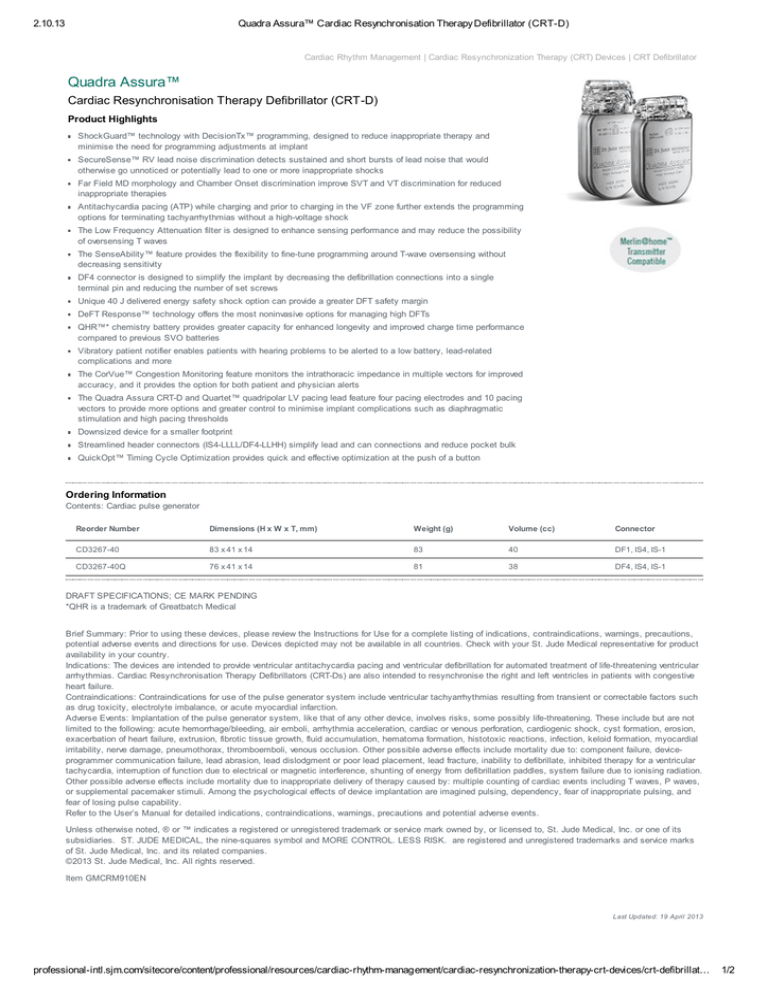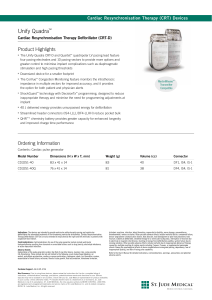
2.10.13
Quadra Assura™ Cardiac Resynchronisation Therapy Defibrillator (CRT-D)
Cardiac Rhythm Management | Cardiac Resynchronization Therapy (CRT) Devices | CRT Defibrillator
Quadra Assura™
Cardiac Resynchronisation Therapy Defibrillator (CRT-D)
Product Highlights
ShockGuard™ technology with DecisionTx™ programming, designed to reduce inappropriate therapy and
minimise the need for programming adjustments at implant
SecureSense™ RV lead noise discrimination detects sustained and short bursts of lead noise that would
otherwise go unnoticed or potentially lead to one or more inappropriate shocks
Far Field MD morphology and Chamber Onset discrimination improve SVT and VT discrimination for reduced
inappropriate therapies
Antitachycardia pacing (ATP) while charging and prior to charging in the VF zone further extends the programming
options for terminating tachyarrhythmias without a high-voltage shock
The Low Frequency Attenuation filter is designed to enhance sensing performance and may reduce the possibility
of oversensing T waves
The SenseAbility™ feature provides the flexibility to fine-tune programming around T-wave oversensing without
decreasing sensitivity
DF4 connector is designed to simplify the implant by decreasing the defibrillation connections into a single
terminal pin and reducing the number of set screws
Unique 40 J delivered energy safety shock option can provide a greater DFT safety margin
DeFT Response™ technology offers the most noninvasive options for managing high DFTs
QHR™* chemistry battery provides greater capacity for enhanced longevity and improved charge time performance
compared to previous SVO batteries
Vibratory patient notifier enables patients with hearing problems to be alerted to a low battery, lead-related
complications and more
The CorVue™ Congestion Monitoring feature monitors the intrathoracic impedance in multiple vectors for improved
accuracy, and it provides the option for both patient and physician alerts
The Quadra Assura CRT-D and Quartet™ quadripolar LV pacing lead feature four pacing electrodes and 10 pacing
vectors to provide more options and greater control to minimise implant complications such as diaphragmatic
stimulation and high pacing thresholds
Downsized device for a smaller footprint
Streamlined header connectors (IS4-LLLL/DF4-LLHH) simplify lead and can connections and reduce pocket bulk
QuickOpt™ Timing Cycle Optimization provides quick and effective optimization at the push of a button
Ordering Information
Contents: Cardiac pulse generator
Reorder Number
Dimensions (H x W x T, mm)
Weight (g)
Volume (cc)
Connector
CD3267-40
83 x 41 x 14
83
40
DF1, IS4, IS-1
CD3267-40Q
76 x 41 x 14
81
38
DF4, IS4, IS-1
DRAFT SPECIFICATIONS; CE MARK PENDING
*QHR is a trademark of Greatbatch Medical
Brief Summary: Prior to using these devices, please review the Instructions for Use for a complete listing of indications, contraindications, warnings, precautions,
potential adverse events and directions for use. Devices depicted may not be available in all countries. Check with your St. Jude Medical representative for product
availability in your country.
Indications: The devices are intended to provide ventricular antitachycardia pacing and ventricular defibrillation for automated treatment of life-threatening ventricular
arrhythmias. Cardiac Resynchronisation Therapy Defibrillators (CRT-Ds) are also intended to resynchronise the right and left ventricles in patients with congestive
heart failure.
Contraindications: Contraindications for use of the pulse generator system include ventricular tachyarrhythmias resulting from transient or correctable factors such
as drug toxicity, electrolyte imbalance, or acute myocardial infarction.
Adverse Events: Implantation of the pulse generator system, like that of any other device, involves risks, some possibly life-threatening. These include but are not
limited to the following: acute hemorrhage/bleeding, air emboli, arrhythmia acceleration, cardiac or venous perforation, cardiogenic shock, cyst formation, erosion,
exacerbation of heart failure, extrusion, fibrotic tissue growth, fluid accumulation, hematoma formation, histotoxic reactions, infection, keloid formation, myocardial
irritability, nerve damage, pneumothorax, thromboemboli, venous occlusion. Other possible adverse effects include mortality due to: component failure, deviceprogrammer communication failure, lead abrasion, lead dislodgment or poor lead placement, lead fracture, inability to defibrillate, inhibited therapy for a ventricular
tachycardia, interruption of function due to electrical or magnetic interference, shunting of energy from defibrillation paddles, system failure due to ionising radiation.
Other possible adverse effects include mortality due to inappropriate delivery of therapy caused by: multiple counting of cardiac events including T waves, P waves,
or supplemental pacemaker stimuli. Among the psychological effects of device implantation are imagined pulsing, dependency, fear of inappropriate pulsing, and
fear of losing pulse capability.
Refer to the User’s Manual for detailed indications, contraindications, warnings, precautions and potential adverse events.
Unless otherwise noted, ® or ™ indicates a registered or unregistered trademark or service mark owned by, or licensed to, St. Jude Medical, Inc. or one of its
subsidiaries. ST. JUDE MEDICAL, the nine-squares symbol and MORE CONTROL. LESS RISK. are registered and unregistered trademarks and service marks
of St. Jude Medical, Inc. and its related companies.
©2013 St. Jude Medical, Inc. All rights reserved.
Item GMCRM910EN
Last Updated: 19 April 2013
professional-intl.sjm.com/sitecore/content/professional/resources/cardiac-rhythm-management/cardiac-resynchronization-therapy-crt-devices/crt-defibrillat…
1/2
2.10.13
Quadra Assura™ Cardiac Resynchronisation Therapy Defibrillator (CRT-D)
professional-intl.sjm.com/sitecore/content/professional/resources/cardiac-rhythm-management/cardiac-resynchronization-therapy-crt-devices/crt-defibrillat…
2/2







